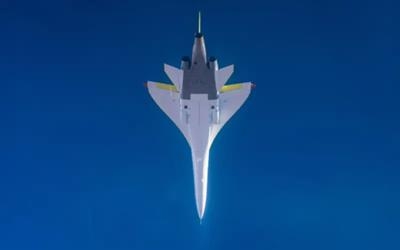Sun, May 18, 2025
Seeking Legalization Of Flight Over Land, Outlawed Since 1973
Senators Ted Budd and Thom Tillis from North Carolina, Utah’s Mike Lee, and Tim Sheehy of Montana were joined by Representatives Sharice Davids of Kansas and Troy Nehls of Texas in introducing bills in their respective chambers to legalize supersonic flight over land, which has been outlawed since 1973 due to the effects of the sonic booms.

In the Senate, S.1759, the Supersonic Aviation Modernization Act or SAM, would enable the operation of civilian supersonic flights within U.S. airspace under certain conditions. Sen. Budd says the regulations should focus on limiting the sound impact of supersonic flight rather than the speed of aircraft.
The reason supersonic flight was restricted was the impact of sonic booms over populated areas. However, recent advancements in mitigating those effects have been the subject of research done by Boom Supersonic, developers of a modern supersonic airliner.
Their aircraft, known as the Overture, is intended to be the next generation of supersonic airliners to significantly shorten travel times.
In January of this year, Boom’s prototype called XB-1, a 1/3 scale demo version of its intended Overture airliner, exceeded the sound barrier in multiple attempts. The company also tested several iterations of mitigating and even eliminating the effect of the sonic boom caused by supersonic flight through technology it calls “boomless” flight.

Boomless flight takes advantage of a phenomenon that causes the boom to reflect off a layer of temperature difference in the atmosphere when the aircraft is flying at certain altitudes and speeds. Sensitive measuring equipment on the ground under the flight path was unable to detect the sonic boom when XB-1 traversed the transonic region of speed between Mach 0.98 and Mach 1.2.
The bills in both chambers will have to be approved out of the appropriate committees and then be debated by the full chamber. If approved in one chamber, the other would also have to approve it before it is sent to the president for his signature.
More News
"Our 6,000th helicopter built in Canada demonstrates our commitment to manufacturing aircraft capable of performing the most critical missions, as well as our dedication to contrib>[...]
(Pilot) Applied Gentle Aft Pressure On The Control Stick To Regain Control, But An Inflight Separation Of The Right Wing Ensued Analysis: The pilot stated the airspeed may have bee>[...]
Aero Linx: Taylorcraft Foundation, Inc. The Foundation typically participates in 3 events each year: Sun-n-Fun; Lakeland Florida USA. Flyin Taylorcraft, Aeronca and Funk: Barber Ai>[...]
Also: Hartzell Pathfinder Carbon Prop, RAF Flyby, Qatar's BIG Boeing Order?, ‘Luxury Aircraft Tax’ Three MB-339 jets from the Italian Air Force’s aerobatic demons>[...]
Aero Linx: International Federation of Air Traffic Controllers' Associations (IFATCA) IFATCA is the recognised international organisation representing air traffic controller associ>[...]
 Aero-News: Quote of the Day (05.15.25)
Aero-News: Quote of the Day (05.15.25) NTSB Final Report: Avia Stroitel AC-5M
NTSB Final Report: Avia Stroitel AC-5M ANN's Daily Aero-Linx (05.15.25)
ANN's Daily Aero-Linx (05.15.25) Airborne 05.09.25: Frecce Tricolori MidAir, A6M3 Zero Returns, Houthis Bombed
Airborne 05.09.25: Frecce Tricolori MidAir, A6M3 Zero Returns, Houthis Bombed ANN's Daily Aero-Linx (05.16.25)
ANN's Daily Aero-Linx (05.16.25)




